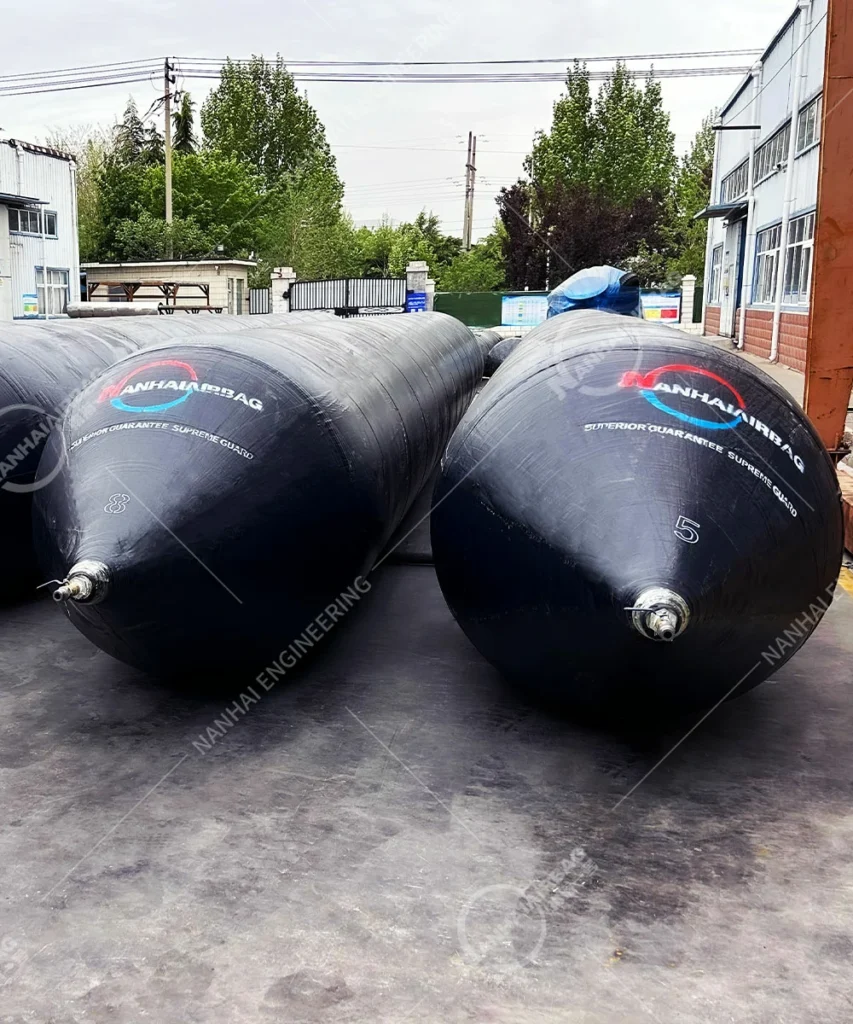Marine Airbags: The Silent Heroes Keeping Ships Afloat and Ports Safe
31/07/2025Donut Foam Fenders: The Circular Guardian of Marina Safety (No More Scratched Hulls!)
07/08/2025

Picture this: A 180-foot cargo ship glides toward a crowded dock at dawn. The tide is rising, the wind is picking up, and the crew needs to position the vessel exactly—too close, and the hull scrapes the pier; too far, and it drifts into rough water. One wrong move could mean thousands in repairs, delayed cargo, or even injury. Enter ship landing airbags: the unsung heroes of modern maritime operations, turning chaotic docking maneuvers into smooth, predictable routines. Let’s break down why these rubbery giants are revolutionizing how ships “land” safely.
What Exactly AreShip Landing Airbags? (The Quick Answer)
Ship landing airbags are portable, inflatable rubber devices designed to guide, stabilize, and protect ships as they dock or settle on shore. Shaped like thick, sturdy sausages (but built for heavy-duty work), they’re made from layers of abrasion-resistant rubber (like EPDM or neoprene) reinforced with steel wires. Unlike cranes or winches, they use compressed air to cushion the ship’s weight, conforming to uneven hulls, slippery surfaces, or tight spaces to prevent damage.
How Do Ship Landing Airbags Work? The “Soft Touch” Magic
These aren’t your average pool toys—they’re engineering marvels tailored for maritime challenges:
1. Inflatable Flexibility = Perfect Positioning
When inflated, airbags mold to the ship’s hull, whether it’s curved, angled, or covered in barnacles. This eliminates sharp pressure points that could crack welds or dent metal—unlike rigid docking tools.
2. Weight Distribution = No More Scratches or Cracks
A single 1.5m-diameter airbag can support up to 30 tons. Stack them side by side, and they’ll cradle a 1,000-ton cargo ship without a scratch. The even weight distribution means no more “scraping” sounds as the hull hits the dock.
3. All-Weather Reliability = Safe in Any Condition
Made with waterproof, UV-resistant rubber, airbags work in rain, wind, or even light ice. Their textured surfaces grip slippery docks, and reinforced seams stand up to rough tides.
Why This Matters: When Docking Goes Wrong, It Costs Everything
Docking might seem routine, but it’s one of the riskiest parts of maritime operations. Let’s look at why traditional methods are no longer enough:
The High Stakes of “Manual” Docking
- Hull Damage: A 2023 report found that 40% of small-boat owners report hull scratches or cracks from docking—repairs average 8kperincident.Foracommercialvessel,thatnumberjumpsto50k–$200k.
- Delays and Lost Revenue: A single misaligned docking can delay a ship by 6–12 hours, costing shipping companies 10k–50k in missed deadlines (think perishable cargo or late fees).
- Crew Safety Risks: In 2022, a crew member in Australia was hospitalized after slipping on a wet dock while trying to secure a drifting fishing boat. Traditional tools like ropes or winches require hands-on work in dangerous conditions.
How Airbags Are Changing the Game
Take Thailand’s Phuket Port: After switching to ship landing airbags, they reduced docking accidents by 65% in one year. A small fishing village in Norway even used portable airbags to dock boats during a storm, avoiding risky manual labor in 30-foot waves.
Why You Can’t Afford to Ignore Ship Landing Airbags
Whether you’re a small boat owner, a port operator, or a commercial shipping company, these airbags solve problems traditional tools can’t:
1. Works for AnyVessel, Big or Small
From kayaks to 10,000-ton tankers, there’s an airbag size for you. Custom options even fit unique hull shapes (like sailboats with keels or barges with flat bottoms).
2. Saves You Money Long-Term
Yes, airbags cost more upfront than basic ropes or fenders. But with fewer repairs, less downtime, and lower insurance premiums, most users recoup their investment in 1–2 years.
3. No Specialized Equipment Needed
forget cranes or heavy machinery. Airbags weigh just 50–150kg each and can be moved by hand (or a small truck). Even remote villages with no dock infrastructure can use them.
People Also Ask: Your Top Questions About Ship Landing Airbags
Q: How are ship landing airbags different from marine fenders?
A: Great question—and a common confusion. Marine fenders (including rubber fenders) absorb impact during berthing(when a ship hits a dock). Ship landing airbags, though, guide and stabilize the ship during the landing processitself, using inflation to cradle the hull and prevent misalignment. They’re often used together: fenders absorb shocks, airbags control positioning.
Q: What sizes are available?
A: They range from tiny (0.8m diameter) for small boats to massive (4m+ diameter) for cargo ships. Custom sizes are common—just let manufacturers know your hull’s length, width, and weight.
Q: Are they easy to set up?
A: Super easy. Most come with adjustable straps or anchor points to secure them to the dock. Crews inflate them with air compressors (or hand pumps for smaller models) in minutes. Many brands even include step-by-step video guides.
Q: Do they work in rough seas?
A: Absolutely. Their flexible, waterproof design handles wind, waves, and ice. Some models have reinforced steel wires to withstand extreme conditions, making them safer than manual docking in storms.
Q: Are they worth the cost?
A: Let’s put it this way: A single avoided hull repair (15k)ordockingdelay(20k) could cover the cost of a mid-sized airbag. For most operators, they pay for themselves in under a year.
Final Thoughts: Don’t Let Docking Disasters Sink Your Business
In maritime work, safety and efficiency aren’t just “nice-to-haves”—they’re the difference between profit and loss, smooth operations and costly chaos. Ship landing airbags aren’t just another tool; they’re the key to docking confidently, no matter the conditions.
Ready to upgrade? Start by researching trusted marine equipment suppliers (look for those specializing in marine airbags) and asking about their docking solutions. Your hull, your crew, and your bottom line will thank you.
